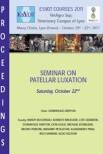OBJECTIVE: To determine the effect of tibial rotation on radiographic tibial plateau angle (TPA) measurement in normal and cranial cruciate ligament (CrCL)-deficient stifles.
STUDY DESIGN: Cadaveric study.
SAMPLE POPULATION: Five pairs of canine cadaver hind limbs with no stifle osteoarthritis.
METHODS: Mediolateral radiographs of each specimen were obtained at 0°, 10°, 20°, and 30° of internal and external rotation of the tibia with both intact and transected CrCL. Two Kirschner wires were placed at the cranial and caudal landmarks of the tibial plateau, and the 0° views were imaged again, representing the anatomic TPA. Five observers measured the TPA twice on all images. Measurements were compared by using a mixed-model ANOVA. Intraobserver and interobserver variability were evaluated by using the coefficient of variation.
RESULTS: Tibial plateau angle did not differ among the anatomic, CrCL-intact, and CrCL-deficient 0° views or between the CrCL-intact and CrCL-deficient views at the various tibial rotations. The only difference detected was between CrCL-intact stifles radiographed at 0° and external rotation (range, 1.16°-1.6°; P = .016, P = .001, and P < .001). Tibial rotation, CrCL transection, and their interaction all failed to influence intraobserver and interobserver variability (P > .05).
CONCLUSION: In CrCL-deficient stifles, tibial rotation of up to 30° internally and externally did not result in clinically relevant changes in TPA measurements.
CLINICAL SIGNIFICANCE: The TPA can be successfully measured with up to 30° of internal and external tibial rotation in CrCL-deficient stifles with no osteoarthritic changes.









